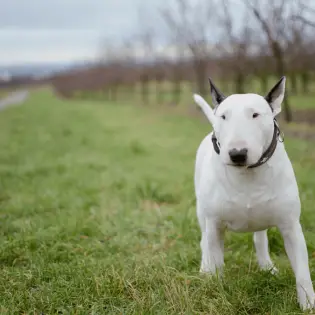English Setter
English Setter is a medium-sized dog breed with a unique and one of the most beautiful coats in the canine kingdom. This is an excellent working breed that, at the same time, makes a great and friendly companion. They are sweet-natured dogs that get along well with everybody, including children and other pets. Because they were bred for work, they could run for hours tirelessly.
FUN FACT: The word „belton“ is unique for English Setter dogs, and it describes the color patterns of their coat: lemon, liver, and orange.

Height:
23-27 in (58-68 cm)

Weight:
45-80 lb (20-36 kg)

Origin:
Great Britain

Life Expectancy:
10-12 years
Dog Breed Characteristics
Appearance
English Setters are on the larger side of the medium-sized dog spectrum. Full-grown female Setters weigh 45–55 pounds and stand 23–25 inches tall, according to The English Setter Association of America (ESAA). Male dogs are larger, weighing 65–80 pounds and standing 25–27 inches tall. Because they were developed to scent airborne scents from birds, English Setters hold their heads high. Their tail is very long, as are their folded ears.

Coat type
One of the English Setter's charms is their attractive coat. The coat is completely flat, with no curls or woolliness. It has feathering — a long fringe of hair — on the ears, chest, belly, underside of the thighs, backs of the legs, and tail: just enough to be pretty but not so much that it impedes the Setter's movement in the field.
Coat color
The stunning English Setter coat is available in various colors and color combinations, including.
- Blue belton - white with black markings
- Orange or lemon belton - white with orange or lemon
- Blue belton and tan - natch, tan markings, making this dog a tricolor
- Liver belton - white with deep reddish-brown marking

The coat is white, with darker hairs interspersed throughout the body. Puppies are typically born white, with patches of orange, black, or liver.
FUN FACT: Belton is a village in which the breed's founder, Edward Laverack, enjoyed hunting.
Temperament
English Setters are gentle and sweet. They are said to be the nicest breed in the Setter family because they love people and get along well with kids and other pets. They are also friendly to strangers, making them unsuitable for the role of a watchdog. They are, however, very alert and will bark to announce visitors – only to happily greet them immediately afterward.
English Setters are extremely active dogs best suited for the active person who will take them on a run, hike, bike ride, or hunt. This is the primary activity for which they were bred. They are demanding in terms of exercise because they enjoy running and playing outside. Still, once their energy has been expended, they also know how to behave properly indoors. They are quiet and calm as long as their energy requirements are met.

The English Setter, due to its high stamina and drive, can become destructive inside the house if not properly exercised. They also tend to bark, dig, and jump, which is why fenced yards are essential. They are not aggressive, and they do not typically exhibit possessive or territorial behavior toward other dogs.
They actually prefer canine companionship, but they will also make friends with other furry pets, especially if they grow up together. They have a strong prey drive that is directed toward birds. Still, because they were not bred to attack but rather to find prey, there are usually no major concerns.
Despite their affectionate temperament, the English Setter is also quite stubborn and independent, making them somewhat challenging to train. Potty training can be tricky, requiring a great deal of patience and consistency. Harsh treatment is not advised because they are sensitive dogs with excellent memory who may resent punishments.
Their good memory is an intriguing aspect of their personality, making bad habits challenging to correct.

English Setters are not well suited to apartment living or being left alone for extended periods of time. They require mental stimulation, activity, and people most of the time. They are good family dogs who will go out of their way to please their owners, even though they are not among the neediest dog breeds and will not live to fulfill their owner's every wish.
Care guide
Setters thrive in the company, so they are best suited to living in a household where they will have company for most of the day. If they are left alone for short periods, you should still work on making them feel relaxed in order to prevent separation anxiety from developing. They require average grooming, with a little more focus on their feathered features. The following are the most critical aspects of English Setter care.
Grooming
An English Setter has a beautiful coat when adequately groomed. Brush your dog at least three times a week, preferably daily, with a stiff bristle brush to keep the skin healthy and the coat shiny. After that, gently remove any tangles or mats with a steel comb.

A bath every 6 - 8 weeks will keep them smelling fresh. English Setter sheds like any other dog, but brushing will help keep loose hair off your clothes and furniture. For a neat appearance, you should also trim stray hairs every six weeks. If you are unsure, you can take your pup to a professional groomer or ask the breeder to show you how to do it safely.
Check and clean the English Setter’s floppy ears weekly to prevent ear infections. They can happen because the specific shape of this breed’s ears obstructs air circulation. Wipe out the visible part of the ear gently with a cotton ball dampened with an ear cleaner recommended by your veterinarian.
Never insert cotton swabs or anything else into the ear canal, as this could cause damage. If the inside of your Setter's ear smells terrible, appears red or tender, or shakes their head or scratches at the ear frequently, they may have an ear infection.
Brush your Setter's teeth at least twice a week to remove tartar and the bacteria living inside it. Brushing twice a day is even better if you want to avoid gum disease and bad breath.
If your dog's nails don't wear down naturally, you should trim them regularly. They're too long if you can hear them clicking on the floor. Short, neatly trimmed nails protect your legs from scratches when your Setter jumps up to greet you.
When your Setter is still a puppy, start accustoming them to being brushed and examined. Handle their paws frequently — dogs' feet are sensitive — and inspect their mouth and ears. Make grooming a pleasurable experience full of praise and rewards. You'll lay the groundwork for easy veterinary exams and other handling when they’re an adult.

Check for sores, rashes, or signs of infection, such as redness, tenderness, or inflammation on the skin, ears, nose, mouth, eyes, and feet as you groom your dog. There should be no redness or discharge in the eyes. Your thorough weekly examination will assist you in detecting potential health issues early on.
Training
Training may be difficult because English Setters are independent thinkers and strong-willed dogs. They can be obstinate and refuse to do what their owners want by simply refusing to act. As a result, a strong, consistent leader will achieve better results. Keep in mind that positive reinforcement with treats and praises works best. Food rewards and praise are always preferred because English Setters are sensitive to punishment or criticism.
Starting as puppies and maintaining regular and scheduled training sessions will be beneficial. Housetraining can be difficult, and the same consistency and patience are required.
Socialization
Early socialization is critical for the mental stability of the dog. Contacting and interacting with various people, animals, sounds, and sights helps dogs become more adaptable to different situations and well-rounded when they reach adulthood. You can take your dog with you while you run errands, and you can even start this process at home.

Wear different clothes, hide, play, and get your dog used to various situations. Invite friends over and play sounds like fireworks or thunderstorms. Your dog will get used to them, and your life will be a lot easier when the dog reaches adulthood. Here are a few tips that might help with that - Puppy socialization.
English Setters and children
English Setters get along well with children and enjoy playing with them. They'll be great for playing with the kids because they're such energetic dogs. Generally speaking, English Setters are amazing with kids. They are patient, gentle, and extremely tolerant.
It is very common for children to cross the line when playing with dogs. They get overly eager and can punch, kick, or pull on the dog’s hair. If that happens, some dog breeds can have a poor reaction. That puts everyone involved in the interaction at risk. It is best to always supervise all interactions between your kids and your dog, no matter what breed you have at home.

English Setters and other pets
If these dogs are raised in the same household as other pets, they will get along with anyone. The only thing you should be cautious of is when your dog is in the presence of birds. English Setters are bird dogs bred for hunting, and you can't expect them not to react when they see a bird. Some dogs can be taught not to chase birds, but it is always best to be cautious and limit their interactions with pets like parrots.
Exercise needs
English Setters demands a daily dose of activities to be happy and healthy. In most cases, a few longer walks will do the trick. You can be sure your dog will enjoy it if you take them jogging, cycling, or hiking. Playing with other dogs is also an excellent option for your dog to spend their energy.
Ensure you don't overtrain your puppy because their bones and joints are still developing. They could have some severe health problems later in life if they do.
If you provide your English Setter with enough daily exercise, you can be sure that your dog will be calm and happy, and you will not have any problems with them at home.

Health problems
English Setters are healthy dogs with a life expectancy of 10-12 years. Like most dogs worldwide, they are also prone to some health problems that every future and current Setter owner should know. Those problems include;
- Hip dysplasia
- Deafness
- Bloat
- Hypothyroidism
- Elbow dysplasia
- Allergies
To ensure you are getting a healthy puppy, never buy it from a questionable source like a pet store or yellow pages. Dog breeders regularly test their breeding dogs, as well as their puppies. This is the only way to ensure you are getting a puppy with the best possible start in life.
English Setter breeders
When searching for English Setter breeders, always check that they are registered with their governing clubs. If possible, check their reputation to be sure that you will end up with the best puppy who will not have any serious congenital problems or inherited diseases.
Always ask the breeder to show you the health certificates of their breeding dogs. When possible, see the puppies' mother in person. Make sure the breeder is taking good care of their dogs and puppies.
World Dog Finder team

Updated at31.08.2023.
Breed History
English Setters have been around for over 400 years, and "setter type" dogs have been depicted in paintings and artwork since the 15th century. They were originally bred to scent game birds silently. When they discovered hiding prey, they would set low and freeze in a characteristic standing position, allowing the hunter to approach and net the birds or, later, shoot them. They were initially known as "setting dogges" because of their distinctive setting stance.
The original Setter breed from Spain, Water Spaniels, English Springer Setters, and Pointers are thought to have been crossed with English Setters. Setters became popular in Britain around the 17th century. The breed evolved into a more specific breed to create the modern-day English Setter.

The English Setter's origins can be traced back to the nineteenth century to two breeders named Edward Laverack and R. Purcell Llewellin. Laverack carefully bred Setters, which resulted in the appearance of show-type Setters. Llewellin, on the other hand, crossed Laverack's dogs with other Setters to create the modern field-type, Setter. Llewellin's main goal was to improve the Setter's scenting ability and speed.
The first English Setter to arrive in America was a Laverack descended from the Laverack bloodline in 1874. This dog breed was very popular in the United Kingdom during the 1960s, 1970s, and 1980s. However, due to a decreased registration numbers in previous years, English Setters were added to the Vulnerable Native Breeds list in 2015.
English Setters are classified into two types: the "bench" or "show" type, which has a longer coat and is slightly less active, and the "field" type, which is smaller, more job-oriented, and thus more energetic. English Setters excel at obedience and agility tasks in addition to hunting. They have been used successfully as therapy dogs due to their loving temperament.

















Share